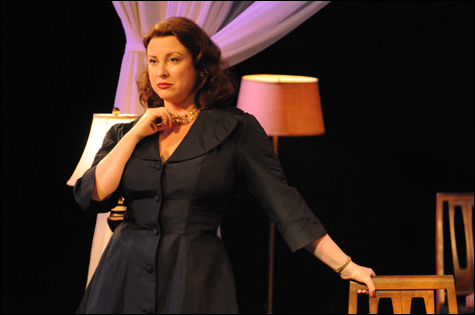
POSITIVELY GREEK: Christine Louise Marshall in the title role.
|
|
Hedda Gabler: A Re-Vision
by Henrik Ibsen | Directed and adapted by Joan Sand | Produced by Mad Horse Theatre Company | at the Studio Theater of Portland Stage Company | through April 20 | 207.730.2389
|
Triangulations are many and charged in the Tesmans’ circle, and for newlywed Hedda Tesman, née Gabler (Christine Louise Marshall), it is imperative to be an apex. Too shrewd and blasé to be satisfied in her cop-out marriage to humdrum academic George, Hedda’s amusements — and her survival strategies — are Machiavellian. They are also her downfall. Though written in 1890, Hedda’s is a timeless tragedy. Mad Horse moves it forward in time, tweaking it beautifully along the way, in Hedda Gabler: A Re-Vision, Joan Sand’s ambitious adaptation of Henrik Ibsen’s classic.
The triangle Hedda forms with fussy George and their lecherous family friend Judge Brack gains several new angles with the reappearance of two figures from the past: Thea Elvsted, an old schoolmate of Hedda, calls upon the Tesmans with concern for Eilert Lovborg, a writer, academic rival of George, and (unbeknownst to anyone else) former lover of Hedda. As the constellations of these five characters shift and increase in stake, Hedda — obsessed with power, having little herself — positions herself for sharp angles.
Playing on its protagonist’s repression under class, gender, and social mores, Sand (who also directs) sets Hedda in a university-town American Midwest of the 1950s. It’s a natural choice, and in Sand’s adaptation both the big themes and the small details of the culture translate well. And the production also looks great, very echt-’50s, with George in a red sweater-vest and dark-rimmed glasses, and Hedda looking proper but dangerously radiant in a vintage petticoated black dress and scarlet lipstick.
Sand’s other directorial decision, this one much more audacious and risky, concerns casting: In this production, Marshall’s Hedda is the only character played by one actor alone. Everyone else (including small roles like the maid and George’s Aunt Juliana) is portrayed via a steady, ensemble-style rotation of Mad Horse talent, who trade simple costumes over black slacks and white shirts. For example, in the first scene George is played by Craig Bowden, the Judge by Peter Brown, and Thea by Lisa Muller-Jones. But in every subsequent scene, the casting schematic is freshly shaken up, to humorous and eventually rather ominous effect.
That might sound gimmicky, but its result approaches brilliance. Handled masterfully by this excellent cast, Sand’s innovation lends a surreal and Expressionist dimension to Hedda’s tortured consciousness. With each new casting, Hedda’s crew of cohorts becomes — as if through Hedda’s eyes — both a little more tiresome and a little stranger; each character seems more and more to exist as a collection of caricatured props and gestures: Thea’s silk scarf and blank gaze, the Judge’s cigar and macho splayed legs, George’s red sweater-vest and nerdy pursed mouth. Seen as if from the increasingly unhinged perspective of Hedda, these are characters who have no meaning for their own sakes, only for their places in her configurations of power. The technique also effectively sets Hedda apart as the center of her own universe, as the one consistent and most important personality amid a lot of slapstick, mechanism, and absurdity.
Similarly smart is how Sand’s production alludes to the dynamics of her chosen era, both mainstream and avant-garde. The play opens with soap-operatic, canned-sounding voices revealing Hedda’s backstory; but then dissonant strings and horns play during scene changes. Between certain scenes, Hedda circles her living room with a stylized, choreographed desperation. As white gauze curtains pick up lurid, ever-changing gels, and as those disturbing strings play away (Sand designed the lights, Barbara Truex the sound; both are excellent), the staging has a touch of both Alfred Hitchcock and Martha Graham. It presents Hedda in a way at once cinematic and sort of neo-mythic: Asleep in a chair, her head bent back, swathed in red chenille, she looks positively Greek in her fierce tragedy, lips so red, pale throat so haughtily exposed.
And as this bewitching but doomed heroine, Marshall gives one of her strongest performances to date. Her tone and timing, like those of the entire cast, are close to impeccable (though as of opening weekend, two crucial scenes could use some tighter pacing, to better clinch their horror). Particularly consummate is how Marshall balances Hedda’s clear, deadly poise against the tics — in expressive fingers and wrists — that betray her. And as Hedda spirals through her constellations, losing her treasured position of apogee, she continues to shine, savage and hurt, but bright.
Megan Grumbling can be reached at
mgrumbling@hotmail.com
.